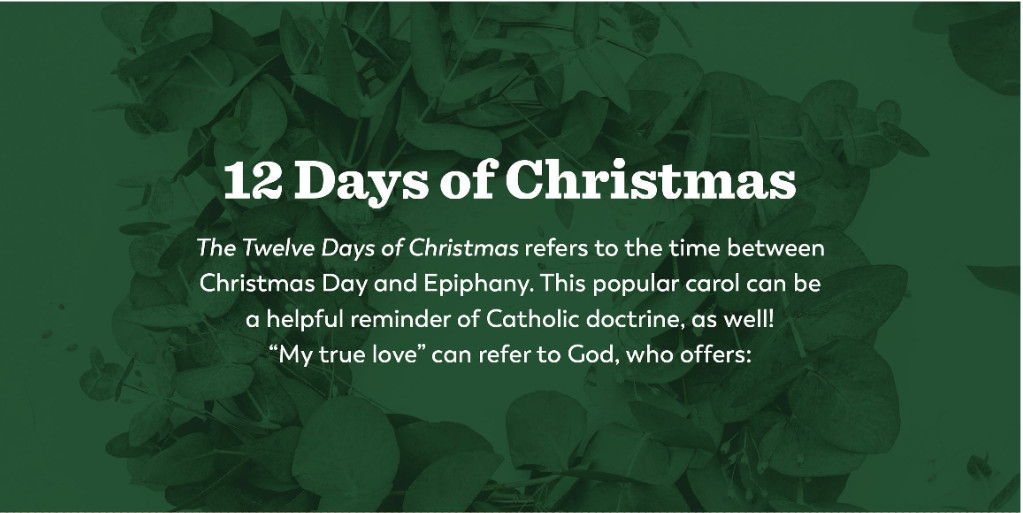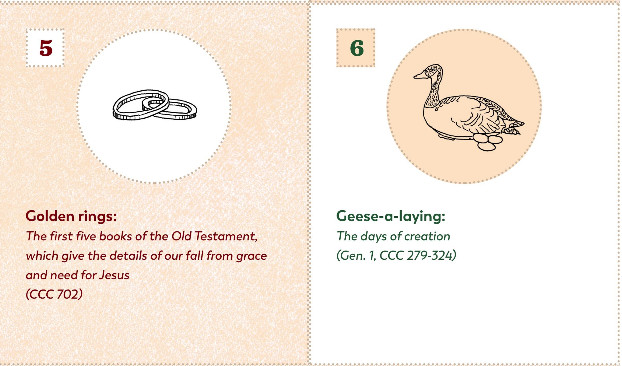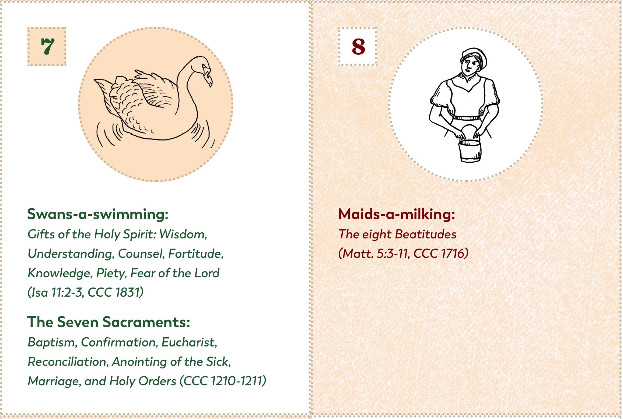The “Twelve Days of Christmas” carol is a holiday tradition as ubiquitous as festive decorations, yet its true meaning often gets overshadowed by popular myths. One widespread theory suggests that this seemingly simple song was actually a secret catechism crafted by persecuted English Catholics during the Reformation. According to this idea, each gift mentioned in the lyrics—from a partridge in a pear tree to twelve drummers drumming—symbolically represents a different aspect of Christian faith. The partridge, for instance, is said to represent Jesus, while the two turtle doves symbolize the Old and New Testaments. This theory posits that the song served as a covert way to educate children about their faith without risking imprisonment or the loss of property.
However, despite its appealing narrative, the secret catechism theory is, unfortunately, unfounded. But this doesn’t diminish the song’s significance or its potential for meaningful interpretation, especially within a Catholic context. In fact, “The Twelve Days of Christmas” still holds profound Catholic meaning, and it’s worth exploring why Catholics should not only embrace it but also understand its deeper message.
Debunking the Secret Catechism Myth of the Twelve Days of Christmas Song
While the idea of a hidden message within a beloved Christmas carol is intriguing, there’s no historical evidence to support the theory that “The Twelve Days Of Christmas Song” originated as a secret catechism for English Catholics. This theory, despite its popularity, lacks factual basis for several key reasons:
Firstly, the historical timeline doesn’t align. “The Twelve Days of Christmas” is believed to have originated in France, with the earliest known written version dating back to 1780. This is significantly later than the Reformation period in England, which primarily occurred in the 16th century. If the song emerged in the late 18th century, it couldn’t have served as a secret catechism during the Reformation.
Secondly, there is a lack of primary source documentation. No historical documents, letters, or testimonies from the Reformation era mention the song or its use as a teaching tool. If such a system existed, it’s highly likely that some record of it would have survived, especially given the significance of religious persecution during that period.
Thirdly, the symbolic interpretations are tenuous and inconsistent. While proponents of the theory have assigned symbolic meanings to each gift, these interpretations are often subjective and don’t consistently reflect core doctrinal differences between Catholicism and Anglicanism during the Reformation. For example, many of the proposed symbols relate to general Christian beliefs shared by both Catholics and Anglicans. A secret catechism would logically focus on points of doctrinal divergence, such as papal authority or the sacraments, which are not explicitly addressed in the commonly proposed interpretations of the song.
 A visual representation of the first day of Christmas from the song, featuring a partridge perched in a pear tree, symbolizing Jesus Christ in the popular catechism theory.
A visual representation of the first day of Christmas from the song, featuring a partridge perched in a pear tree, symbolizing Jesus Christ in the popular catechism theory.
The theory gained traction largely due to the work of Fr. Hal Stockert, who in 1982 published an essay proposing the catechism interpretation. While Fr. Stockert’s theory became widely circulated, particularly through chain emails in the pre-internet era, the evidence he presented was ultimately unsubstantiated. Claims of discovering the symbolism in old letters from Irish priests were later retracted due to the alleged loss of these sources. While the appeal of a hidden message in a classic carol is undeniable, it’s crucial to acknowledge that the secret catechism theory is more of a modern myth than a historical reality.
The True Origins of “The Twelve Days of Christmas”
While the secret catechism theory is debunked, understanding the actual origins of “The Twelve Days of Christmas song” adds another layer to its appreciation. The song most likely originated as a memory and forfeit game in France. Its first documented appearance is around 1780 in England, in a children’s book titled “Mirth Without Mischief.” Early versions of the lyrics varied considerably from the standardized version we know today. Interestingly, some early versions even included less savory gifts, like “a bear-baiting” – reflecting the cultural norms of the time, where blood sports were, surprisingly, considered acceptable forms of entertainment.
 Depiction of two turtle doves, representing the Old and New Testaments according to the symbolic interpretation of the Twelve Days of Christmas song.
Depiction of two turtle doves, representing the Old and New Testaments according to the symbolic interpretation of the Twelve Days of Christmas song.
The evolution of the lyrics over time highlights the song’s folk tradition roots, changing and adapting as it was passed down orally and through early printed versions. This fluid history contrasts sharply with the rigid structure implied by the secret catechism theory. Instead of a coded religious text, the song was more likely a cumulative rhyme, designed for amusement and social interaction.
Why Catholics Should Still Embrace the Twelve Days of Christmas Song
Despite the debunking of the secret catechism theory, there are compelling reasons for Catholics to embrace and even reclaim “The Twelve Days of Christmas song”. Firstly, the lack of a historical catechism doesn’t preclude present-day catechetical use. While the song wasn’t originally intended to teach religious doctrine, its repetitive structure and memorable imagery provide a fantastic framework for contemporary religious education. Assigning symbolic meaning to the gifts, even if not historically accurate, can be a creative and engaging way to teach children and even adults about various aspects of the Christian faith. Personal interpretations can be just as valuable, sparking reflection and discussion about faith during the Christmas season.
Secondly, assigning meaning can enhance appreciation for a somewhat repetitive song. Let’s be honest, “The Twelve Days of Christmas” can be musically… challenging for some. Giving the lyrics a deeper meaning can make listening to it, especially at children’s Christmas concerts, a more engaging and even enjoyable experience. Knowing that each verse can represent a different aspect of faith transforms the song from a simple counting rhyme into a potential meditation on the gifts of Christmas.
Most importantly, the song serves as a crucial reminder that Christmas is not just a single day. In secular culture, and even in some Christian traditions, Christmas celebrations often peak on December 25th and then abruptly end. However, in the Catholic Church, the Christmas season extends far beyond Christmas Day, lasting from Christmas Eve until the Feast of the Baptism of the Lord. “The Twelve Days of Christmas” song perfectly aligns with this liturgical reality, highlighting the twelve days after Christmas Day as a distinct and important season.
These twelve days are rich with significant feasts and solemnities in the Catholic calendar, often overlooked in the rush of December 25th. These include:
- December 26: St. Stephen, the First Martyr
- December 27: St. John the Evangelist
- December 28: The Holy Innocents
- December 29: The Holy Family
- January 1: Mary, Mother of God
- January 6: Epiphany
 Image of four calling birds, symbolizing the four Gospels in the context of the Twelve Days of Christmas song and its symbolic interpretations.
Image of four calling birds, symbolizing the four Gospels in the context of the Twelve Days of Christmas song and its symbolic interpretations.
Understanding and celebrating these twelve days helps Catholics fully embrace the Christmas season in its liturgical richness. The song, therefore, becomes more than just a catchy tune; it becomes a cultural artifact that points to a deeper theological truth about the extended celebration of Christ’s birth. It’s a reminder that the joy and meaning of Christmas unfold over time, inviting us to contemplate the various facets of the Incarnation throughout this sacred season.
Even if the popular secret catechism theory is inaccurate, “The Twelve Days of Christmas song” retains its value. In a world facing cultural and even spiritual crises, simple tools like a counting song can become powerful reminders of faith traditions. It can be a starting point for deeper conversations about the Christmas season, its liturgical significance, and the enduring gifts of faith. The “True Love” in the song, ultimately, can be seen as God, offering us abundant gifts throughout the entire Christmas season and beyond.
 Image of six geese a-laying, symbolically linked to the six days of creation in interpretations of the Twelve Days of Christmas song.
Image of six geese a-laying, symbolically linked to the six days of creation in interpretations of the Twelve Days of Christmas song.
You May Also Like:
What Are the 12 Days of Christmas Really About?
The Stories Behind Our Most Beloved Christmas Carols
Continuing Christmas into the New Year
 Melissa Keating, writer and content strategist, pictured in a warm setting, representing her expertise in Catholic content creation.
Melissa Keating, writer and content strategist, pictured in a warm setting, representing her expertise in Catholic content creation.
Melissa Keating is a writer, editor, and content strategist based in St. Louis. She has been writing weird things that Catholics seem to like since her freshman year at Benedictine College in Atchison, Kansas, where she graduated with degrees in communications and foreign languages in 2012. Melissa then took her oddball talents to the Fellowship of Catholic University Students (FOCUS), where she helped found the Digital Campus. She has worked on award-winning multi-media stories for the Archdiocese of Denver and contributed to The Catholic Hipster Handbook before moving back home to St. Louis, where she helped parishes start support groups for the bereaved and the divorced and separated.
Featured photo by Jonathan Meyer from Pexels

